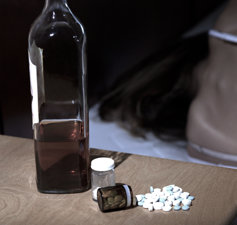Polysubstance Use: What Is It? What Are the Dangers?

What is polysubstance use? It’s the consumption of more than one drug simultaneously or in succession. While your news headlines may talk about “heroin deaths” or “fentanyl overdoses,” the fact is that nearly half of all overdose deaths involve more than one drug. So many people abuse multiple substances that focusing on individual drug problems may miss the real nature of the problem.
Knowing why people use more than one drug and which combinations of drugs are the most common can improve one’s understanding of the problem of polysubstance use.
Why People Are Polysubstance Users
Drug users will often mix drugs or take them in succession to create a specific effect or alleviate the undesirable effects of a single drug. For example:
- A sedating drug will help a person come down from a stimulant high.
- Two drugs together may cause a cumulative effect for the user.
- A combination may enhance the effects of one of the drugs.
- Another combination may prolong drug effects considered desirable by the user.
Common Combinations
Stimulants and opioids (speedballs): An opioid like heroin will slow a person down, making them drowsy. It slows breathing. Adding a stimulant like cocaine speeds up the heart and breathing and provides a burst of energy. A person may combine these drugs to cancel out the slowing effect of the opioid. However, the combination puts the body under severe strain. Also, cocaine’s effects wear off more quickly than those of heroin, which may mean that a person choosing to speedball may consume more cocaine than if they were using that drug alone. This is a very common drug combination—research has shown that between 30% and 80% of heroin users also use cocaine.
Stimulants and opioids in succession: It is not uncommon for heroin or other opioid users to rely on a stimulant like cocaine or methamphetamine to keep them more active. They may take the opioid at night and the stimulant first thing in the morning to help them wake up.

Alcohol and marijuana: Both alcohol and marijuana are in widespread use. In social situations, many people use both drugs together. However, the combination seriously impacts a person’s ability to think clearly and make the right decisions. This can lead to increased impulsivity and poor judgment. Alcohol can also intensify the effects of a drug like cannabis, resulting in increased anxiety and hallucinations. Further, while the use of either drug increases one’s risk of a traffic accident, the use of the two together increases this risk 10 to 15 times.
Alcohol and cocaine: Alcohol and cocaine are frequently used together in a party or club atmosphere. The use of these drugs concurrently produces another psychoactive substance: cocaethylene. This new drug, which has similar effects as cocaine, is removed from the body slowly, which prolongs the cocaine-like effects. But cocaethylene production is associated with seizures, liver damage, and harm to the immune system. It is far more likely to cause death than cocaine alone.

Alcohol and benzodiazepines: Benzodiazepines include Xanax, Ativan, Halcyon, and Valium. Both alcohol and benzodiazepines suppress the central nervous system. Combining them doubles this effect, which can easily create an accidental death.
Opioids with acetaminophen: Drugs like Vicodin and Lortab combine hydrocodone with acetaminophen, a non-steroidal pain reliever. While hydrocodone is a widely abused opioid and can cause overdoses, the high dosages of acetaminophen consumed when a person is addicted to hydrocodone can do their own damage. Overuse of acetaminophen is associated with liver failure, kidney impairment, and stomach hemorrhage. A person misusing a prescription pain reliever may not even know about the harm that can result from their high consumption of acetaminophen.
Alcohol and hydrocodone or oxycodone: As with alcohol and benzodiazepines, both these types of drugs suppress the central nervous system, which can lead to slowed breathing, resulting in coma, brain damage, or death. The same effect is true for any of the dozens of different opioid pain relievers. This can happen whether the drugs are used at the same time or in succession.
Mixing stimulants: A person out at a club may decide to mix ecstasy with cocaine or amphetamine. If they do so, they can elevate their heart rate and blood pressure to such high levels that brain injury, heart attack, or stroke become more likely.
Opioids and benzodiazepines: This combination has long been popular among opioid users, as it is said to create a high similar to that of heroin. Some users also add carisoprodol, a muscle relaxant. These three drugs are sometimes referred to as a “Houston cocktail.” But since opioids and benzodiazepines both depress the central nervous system, the risk of a fatal overdose increases.
Club drugs and many other drugs: Club drug users are very likely to be polysubstance users. One survey of 400 New York City young adults who frequented clubs and were also drug users revealed that nearly 92% of them had been polydrug users. This study found that they chose combinations of ecstasy, ketamine, cocaine, marijuana, LSD, GHB, and alcohol. It is very easy for these combinations to result in addiction, loss of the ability to feel pleasure, depression, or overdose deaths.
Problems Caused by Polysubstance Use
As mentioned, focusing on the problems created by a single drug such as heroin, fentanyl, or cocaine is likely to miss the real situation of polysubstance use. Once a person becomes dependent on one drug, they are increasingly susceptible to developing a dependence on other substances. For example, alcohol misusers are twice as likely to become dependent on an opioid; cocaine users are 15 times as likely to become dependent on opioids.

Being addicted to more than one drug may complicate matters when that person goes to rehab. And what if they land in the hospital? It becomes more difficult to sort out the person’s problems if they suffer an overdose or serious adverse reaction. Which drug is the major factor in their distress?
Unfortunately, the problem of polysubstance use is often neglected in scientific studies as the use of multiple substances usually disqualifies subjects for inclusion. This exclusion can impede the development of drug rehabilitation that serves the needs of this group.
Underage drinkers and young adults may be particularly prone to problematic polysubstance use. Among underage drinkers, 21% of them arriving in an emergency room for an alcohol-related problem were there for problems with both drugs and alcohol.
Young polysubstance users have more vulnerability than older individuals to suffer worse effects from this complex problem. They are more likely to use drugs in a problematic way, relapse after rehab, or suffer serious emotional and mental effects. Thus, among the young, it may be even more vital to help a young person break this bad habit as soon as it starts.
Drug Rehab is Essential at All Ages
One thing is clear: at any age, polysubstance use is as highly dangerous as it is common. Whether a person is using a single drug or several, getting them into an effective drug rehab may be the move that saves their life. With the fatality of some of these combinations, there is not a moment to lose.
Sources:
- CDC. “Polysubstance Use Facts.” CDC, 2020. CDC.
- Frontiers in Medicine. “One Is Not Enough: Understanding and Modeling Polysubstance Use.” Frontiers in Medicine, 2020. Frontiers in Medicine.
- Institute of Living. “Marijuana vs. Alcohol: What’s The Difference in Impaired Driving.” Institute of Living, 2022. Institute of Living.
- National Library of Medicine. “Cocaethylene toxicity.” NLM, 1997. NLM.
- National Library of Medicine. “Polydrug use among club-going young adults recruited through time-space sampling.” https://www.ncbi.nlm.nih.gov/pmc/articles/PMC2683356/ 2010
- National Library of Medicine. “Emergency Department Visits Involving Underage Alcohol Misuse: 2010 to 2013.” NLM, 2017. NLM.
- National Library of Medicine. “The emergence of co-occurring adolescent polysubstance use and depressive symptoms.” NLM, 2019. NLM.


 ®
®